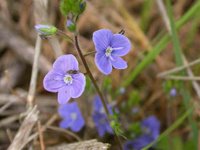 Scilla siberica is a native of the woodlands of Eurasia. A century or so ago, planting its tiny bulbs was all the rage and today, many old homesteads have sections of lawn that, in early April, turn blue with thousands of small flowers that have spread from those old plantings. If the weather remains cool, the blossoms can last for weeks, providing not only beauty for the eye but nourishment for bees.
Scilla siberica is a native of the woodlands of Eurasia. A century or so ago, planting its tiny bulbs was all the rage and today, many old homesteads have sections of lawn that, in early April, turn blue with thousands of small flowers that have spread from those old plantings. If the weather remains cool, the blossoms can last for weeks, providing not only beauty for the eye but nourishment for bees.It explains why, when so many other flowers are gobbled by the hungry deer, scilla blooms brightly and plentifully – as long as lawns remain poison-free.




